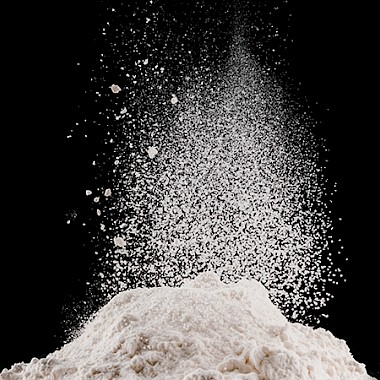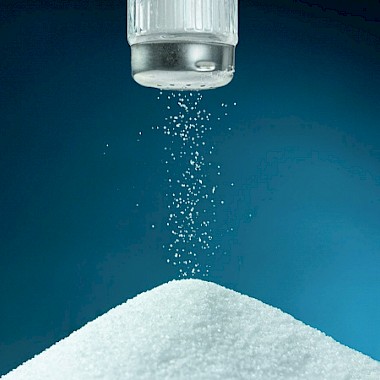Vibratory bin activator
Good Vibrations with the BAV
We frequently address typical problems encountered during discharging and refilling processes and explain what the technical solutions to these problems are. Here we present the Vibratory Bin Activator, or BAV, to give it its German acronym.
Flow properties as distinct as bulk materials themselves
Refilling sounds like it should be an easy task. Yet the flow properties of a bulk material are as distinct as its specific composition. This is already apparent during storage and in particular during discharging and refilling processes. Classic examples of bulk materials that flow extremely poorly include flour, starch, titanium dioxide or chalk. Given their compacting flow properties, they cannot be discharged uniformly and as a result of their high degree of bridging tension, they compact in the discharge zone. This clogs up with product over time, which can result in malfunctions or even equipment damage.
Common refill problems and how to solve them
“The Brabender”: reliable and versatile
A vibratory bin activator, BAV for short, aids the non-compacting discharge of all bulk materials from silos or bins – except for liquids. The first BAV, or “the Brabender”, as this bin activator is called by customers, was unveiled more than 50 years ago. Brabender Technologie has continuously enhanced it since then – up until the current version, the 04, which is very versatile and can be used in almost all sectors of industry. On request, the BAV is also available as a Hygienic Design version made of stainless steel or as an explosion-proof ATEX version. It is temperature-resistant up to +150 degrees Celsius, pressure- and impact-resistant and is even non-sensitive to vacuums if fitted with special safeguards.
How is the outlet relieved to avoid product clogging?
The BAV is installed beneath a silo or bin and its vibrating discharge bottom ensures uniform, continuous product discharge. The key here is the annular clearance, the clearance between the so-called relief plate and the ring-shaped outer wall. Acting as a “double bottom”, the relief plate absorbs the material pressure of the product mass in the bin. This prevents material pressure from bearing down on the outlet of the double bottom and therefore product clogging.
Individual settings options
Michael Katzbach, Head of the Spare Parts department at Kubota Brabender Technologie, explains: “Capacity is always calculated by factoring in the size of the annular clearance. Here, the annular clearance to outlet diameter ratio is key. If the annular clearance is too large, the flow property improvement effect that the relief plate is intended to achieve is canceled out.” Given the range of version options available, the annular clearance can be customized to meet an application’s specific requirements, if needed.
On request, we can custom-manufacture the BAV to meet the requirements of a particular application.Antonio Seising, Head of Sales, Kubota Brabender Technologie
When are ventilation nozzles an option?
If required, the side wall of the discharge bottom can also be fitted with compressed air nozzles. The blasts of compressed air emitted from the nozzles form a lateral air cushion between the adhering product and the bin wall. They reduce friction and activate (not fluidize) the compacted product in the discharge zone. Michael Katzbach points out a possible disadvantage in this regard: “Where a downstream feeding process is involved, the feed screw is no longer able to deliver precision control of the product, which now has substantially altered flow properties. Furthermore, sufficient ventilation should be ensured at all times to avoid impacting on the feeding process.”
Good vibrations with two vibration motors
One or two vibrations motors generate vibrations, depending on the size of the BAV. “The smaller bin activators up to the 1504 model usually feature a higher speed and frequency, which causes the bottom to vibrate. The large bin activators are equipped with two motors, because the product would otherwise be discharged in a lopsided fashion. The motors are installed facing each other and are self-synchronizing,” Michael Katzbach explains. The vibration motor relays the vibrations generated by unbalance weights to the discharge bottom, to which it is firmly attached. The unbalance weights consist of two half-discs, the position of which relative to one another determines the unbalance magnitude. This is matched to specific usage and discharge conditions in each case.
Let us advice you!
Would you like to know if there is a better refilling method for your poorly flowing bulk materials?
Contact Head of Sales Antonio Seising:
Vibrational energy should only be as strong as necessary
If the vibration motor’s unbalance setting is too high, there is a risk of the product clogging or compacting in the discharge bottom or a risk of equipment damage. “Vibrational energy should therefore only be as strong as necessary and as low as possible,” the BAV expert recommends. If both vibration motors have different unbalance settings, undefined spinning motions can also wreck the equipment. Michael Katzbach emphasizes: “Both vibration motors must therefore be operated at the same unbalance setting.”
Everything from a single source
“The particular feature of our business is the fact that we are a single-source provider,” says Michael Katzbach in summary. “Our USP is that we can custom-manufacture vibratory bin activators to match the specific requirements of particular applications. Any customer who is unsure about what flow properties their product has should contact us first. If needed, we can analyze a sample beforehand, to ensure that the vibratory bin activator later matches the application exactly.”
Less is more is what applies to the BAV. If customers factor in sparing consumption of energy and smart use of the annular clearance, the “Brabender” will reward them with a long service life – always relative to the abrasiveness of the bulk material concerned, of course.
Find out more about our discharging and refilling solutions in our overview brochure.

